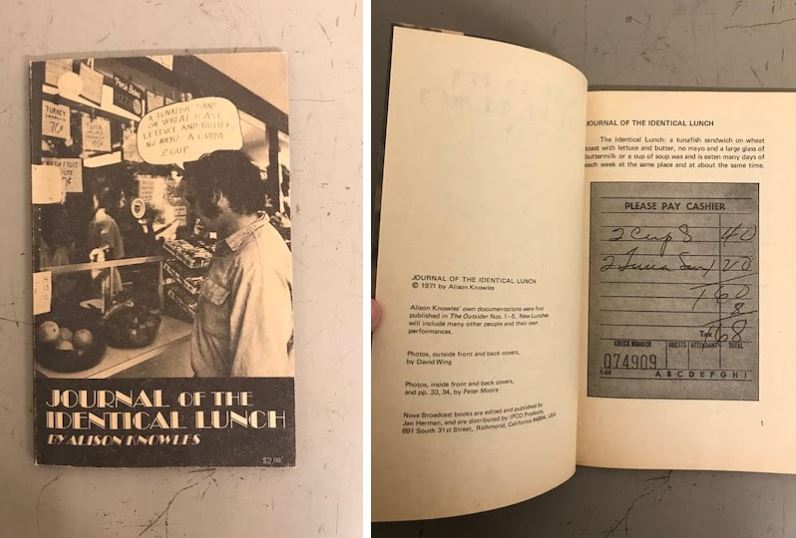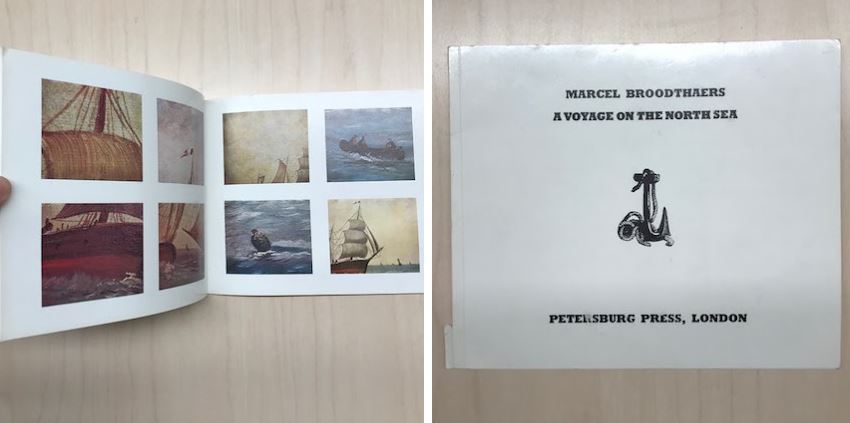Books are often created to accompany live performances and exhibitions - these often take the form of book art. How does context and knowledge of these performances affect the understanding of these pieces?
A recent visit to the library by a group of sculpture students had me pull a few books meant to accompany or document performance pieces: Margot Lovejoy’s Labyrinth, Alison Knowles’ Journal of the Identical Lunch, and Marcel Broodthaers’ A Voyage on the North Sea.* The three books represent three different approaches to the relationship between performance and books which shade the understanding of each piece as a stand-alone object.
Lovejoy’s Labyrinth recreates an immersive experience. Lovejoy presents a series of spreads with flaps and gatefolds which slow the pace of reading. The book is composed entirely of collaged images, text only appearing on the title and table of contents pages. In the original live installation, Lovejoy had attendees wear masks and follow a rope through a labyrinth to arrive at multiple screens of projected images. Though the book is inspired by and a continuation of the installation by Lovejoy, Labyrinth is able to convey a complete message on its own. The understanding of the book is enhanced by knowledge of a previous event but it is not dependent on that knowledge.

Margot Lovejoy’s Labyrinth
Knowles’ Journal of the Identical Lunch presents documentation of a series of events enacted under the umbrella of one piece — eating (and having others eat) a lunch of a cup of soup, a tunafish [sic] sandwich, and a glass of buttermilk. The spreads present receipts, textual documentation, and other correspondence and ephemera related to the enactment of ordering and eating the identical lunch. While knowledge of the performance is required to understand the book, the book itself provides the context for understanding the performance.

Alison Knowles’ Journal of the Identical Lunch
Broodthaers, in A Voyage on the North Sea book, presents one-half of a whole piece. Originally created as a film and book duo, the book relies on two images (one painted, one a photograph) of ships, presumably in the North Sea. The book features a repetition of blown-up shots focusing on particular parts of the painting. I cannot present an overview of the film as the collection I work with only has the book. The film and book were meant to be experienced as one and it’s impossible to imagine what this experience or reading of the work would have been without the full piece. And yet, here the book exists, actively being presented without its other half. In this case, the meaning of the book is completely lost without the understanding of the performance.

Marcel Broodthaers’ A Voyage on the North Sea
As the students spent time with each piece and began asking questions, I started to doubt my decision to include the Broodthaers book in class. I began to question my responsibilities as a librarian and as an artist — is it irresponsible to share works in a way so far removed from the artists’ original intent, so out of context? Or, as artists do we accept that works continue as living documents beyond our control, themselves enacting a different performativity in reading and reception? Can works which were inspired by or rely on performance and events ever truly stand alone, or should that specific context always be provided?
* All three books are discussed in Johanna Drucker’s The Century of Artists' Books but this was coincidental.
Bibliography
Broodthaers, M. (1974). A Voyage on the North Sea. London: Petersburg Press.
Doǧu, H. (1992). Art Documentation: Journal of the Art Libraries Society of North America, 11(3), 158-159. Retrieved from http://www.jstor.org/stable/27948471
Drucker, J., & Granary Books. (1995). The century of artists' books. New York City: Granary Books.
Knowles, A. (1971). Journal of the Identical Lunch. San Francisco: Nova Broadcast Press.
Lovejoy, M. (1991). Labyrinth : A montage book. United States]: M. Lovejoy.
Andrea Kohashi is a book artist and librarian residing in Richmond, Virginia. She is the Teaching and Learning Librarian at Virginia Commonwealth University’s Special Collections and Archives. Kohashi received her MFA in Book Arts and MA in Library and Information Science from the University of Iowa.

